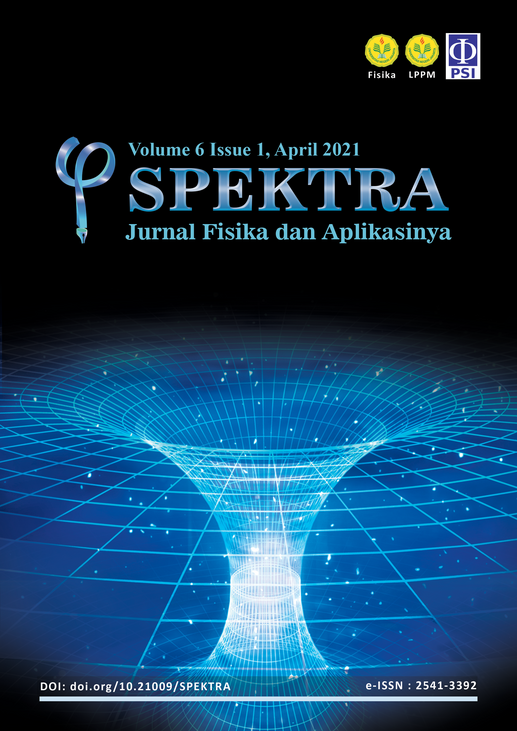THE DEVELOPMENT OF IMAGE PROCESSING METHOD ON THE AUTOMATIC READING SYSTEM OF THE GLASS THERMOMETER USING A DIGITAL CAMERA
DOI:
https://doi.org/10.21009/SPEKTRA.061.01Keywords:
LiGT, image processing, automated reading, temperature measurementAbstract
The reading performance of an analog thermometer, Liquid in Glass Thermometer (LiGT), can be improved using a digital camera. The aim is to minimize the human error on the reading of LiGT and increase the accuracy of temperature measurement results. In order to achieve an accurate result, a robust image processing method is required in the measurement. In this work, the LiGT image generated using a digital camera is analyzed using the technique in HSV color space which consists of some image processing methods (e.g., thresholding, morphology filter). The type of LiGT used is the glass thermometer with the colored liquid. There are three main parts to this developed technique process, i.e., identifying the scale of LiGT to calculate the pixel per temperature unit value (ppt), segmentation of the liquid column, and calculate the temperature based on the ppt value. Through simulation with a synthetic image, we demonstrate that the developed technique in this work has successfully read (measured) the temperature value of the LiGT (having a scale unit of 1oC) with a measurement error of 0.04oC. In the experimental results, we also report the developed technique performed on a real image of LiGT.
References
[2] ORGANISATION INTERNATIONALE DE MÉTROLOGIE LÉGALE, “Recommendation OIML R 133: Liquid In Glass Thermometer,” vol. 2002, 2002.
[3] C. William, Dunn, “Fundamentals of Industrial Instrumentation and Process Control,” New York: McGraw Hill, 2018.
[4] I. Pu et al., “Methods of Reading Liquid-in-Glass Thermometers,” vol. 68, no. 4, pp. 225-230, 2001.
[5] V. Batagelj, J. Bojkovski, and I. Pušnik, “Reading of Thermometers using a Video Camera,” 2000.
[6] B. Herlambang, D. Larasati, and A. Prihartono, “Peningkatan Kemampuan Sistem Kalibrasi Termometer,” pp. 34-43, 2018.
[7] X. Yi et al., “Reading Identification Algorithms of Mercury Thermometer Based on Machine Vision,” pp. 232-235, 2009.
[8] J. C. P. Cheung et al., “An Automated Thermometer Calibration System Imaging Technology: An Automated Thermometer Calibration System Using Optical Character Recognition and Video Imaging Technology,” vol. 5775, May 2016.
[9] Roy Davies, “Computer Vision,” 2017.
[10] C. Learning, A. R. Reserved, and C. Learning, “Image Processing,” Analysis, and Machine Vision, 2015.
[11] R. Hassan, R. R. Ema, and T. Islam, “Color Image Segmentation using Automated,” vol. 17, no. 2, 2017.
[12] P. Widodo, G. D. Haryadi, and A. Widodo, “Induction Motor Centrifugal Blower Health Diagnostic Based on Color Segmentation of Thermal Image and Vibration Signal Feature,” vol. 2002, pp. 1-6, 2018.
[13] J. Wang et al., “Quantitative Analysis on Mathematical Morphology,” 2018 12th IEEE Int. Conf. Anti-counterfeiting, Secur. Identif, no. 4, pp. 103-106, 2018.
[14] Y. Wu, X. Peng, and K. Ruan, “Improved image segmentation method based on morphological reconstruction,” Multimed. Tools Appl, 2015.
Downloads
Published
How to Cite
Issue
Section
License
SPEKTRA: Jurnal Fisika dan Aplikasinya allow the author(s) to hold the copyright without restrictions and allow the author(s) to retain publishing rights without restrictions. SPEKTRA: Jurnal Fisika dan Aplikasinya CC-BY or an equivalent license as the optimal license for the publication, distribution, use, and reuse of scholarly work. In developing strategy and setting priorities, SPEKTRA: Jurnal Fisika dan Aplikasinya recognize that free access is better than priced access, libre access is better than free access, and libre under CC-BY or the equivalent is better than libre under more restrictive open licenses. We should achieve what we can when we can. We should not delay achieving free in order to achieve libre, and we should not stop with free when we can achieve libre.
 SPEKTRA: Jurnal Fisika dan Aplikasinya is licensed under a Creative Commons Attribution 4.0 International License.
SPEKTRA: Jurnal Fisika dan Aplikasinya is licensed under a Creative Commons Attribution 4.0 International License.
You are free to:
Share - copy and redistribute the material in any medium or format
Adapt - remix, transform, and build upon the material for any purpose, even commercially.
The licensor cannot revoke these freedoms as long as you follow the license terms.

 E-ISSN 2541-3392
E-ISSN 2541-3392  Focus & Scope
Focus & Scope  Editorial Team
Editorial Team  Reviewer Team
Reviewer Team  Author Guidelines
Author Guidelines  Article Template
Article Template  Author Fee
Author Fee  Publication Ethics
Publication Ethics  Plagiarism Policy
Plagiarism Policy  Open Access Policy
Open Access Policy  Peer Review Process
Peer Review Process  Retraction & Correction
Retraction & Correction  Licensing & Copyright
Licensing & Copyright  Archiving & Repository
Archiving & Repository  Contact
Contact  Mendeley
Mendeley 

